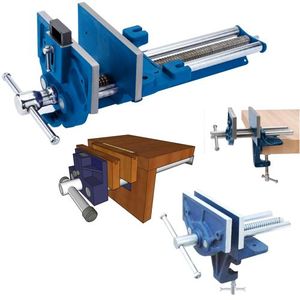Carpenters Vice: Difference between revisions
From DT Online
m (Added links) |
mNo edit summary |
||
| (One intermediate revision by the same user not shown) | |||
| Line 1: | Line 1: | ||
[[File:WoodVices.jpg|300px|right]] | [[File:WoodVices.jpg|300px|right|link=http://www.amazon.co.uk/gp/product/B0000223R6/ref=as_li_tl?ie=UTF8&camp=1634&creative=6738&creativeASIN=B0000223R6&linkCode=as2&tag=dton06-21]] | ||
__TOC__ | |||
=====Description===== | |||
[https://en.wikipedia.org/wiki/Vise '''Vices'''] for woodworking are usually fixed to the underside of the bench top such that the metal parts lie a little below it. This prevents contact with sharp edge woodworking tools to avoid blunting them. | [https://en.wikipedia.org/wiki/Vise '''Vices'''] for woodworking are usually fixed to the underside of the bench top such that the metal parts lie a little below it. This prevents contact with sharp edge woodworking tools to avoid blunting them. | ||
=====Features and Applications===== | |||
[[File:WoodViceFacings.png|300px|right]] | |||
The jaws are lined with wood facings to protect work and these extend above the metal parts to become flush with the bench top. Best practice would ensure the wood [https://en.wikipedia.org/wiki/Wood_grain '''Grain'''] runs vertically, to avoid facings splitting off under pressure, topped with a lipping to stop [https://en.wikipedia.org/wiki/Wood_grain '''End Grain'''] of facings splitting out when planing work held close to the vice. | The jaws are lined with wood facings to protect work and these extend above the metal parts to become flush with the bench top. Best practice would ensure the wood [https://en.wikipedia.org/wiki/Wood_grain '''Grain'''] runs vertically, to avoid facings splitting off under pressure, topped with a lipping to stop [https://en.wikipedia.org/wiki/Wood_grain '''End Grain'''] of facings splitting out when planing work held close to the vice. | ||
| Line 11: | Line 19: | ||
Clamp-on portable versions are also available. These too should normally be faced with timber but some are available with plastic jaws. | Clamp-on portable versions are also available. These too should normally be faced with timber but some are available with plastic jaws. | ||
{{Carpenters Vices Buyers Guide}} | |||
[[Category:Primary]] | [[Category:Primary]] | ||
[[Category:Secondary]] | [[Category:Secondary]] | ||
[[Category:Holding and Clamping Tools]] | [[Category:Holding and Clamping Tools]] | ||
Latest revision as of 09:48, 8 May 2018
Description
Vices for woodworking are usually fixed to the underside of the bench top such that the metal parts lie a little below it. This prevents contact with sharp edge woodworking tools to avoid blunting them.
Features and Applications
The jaws are lined with wood facings to protect work and these extend above the metal parts to become flush with the bench top. Best practice would ensure the wood Grain runs vertically, to avoid facings splitting off under pressure, topped with a lipping to stop End Grain of facings splitting out when planing work held close to the vice.
Some vices have a quick release and adjustable ‘dogs’ which can be raised above the jaws to enable the vice to be used for cramping large pieces of work against opposing ‘dogs’ set into the bench top.
Clamp-on portable versions are also available. These too should normally be faced with timber but some are available with plastic jaws.










